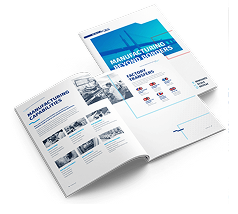With the advancements of AI and Machine Learning dominating headlines, it’s easy to assume that skilled human labour is slowly but surely becoming obsolete, especially in fields like mechatronics engineering. However, the reality is that this is far from true.
Technological advancements are reshaping the roles of skilled professionals rather than replacing them, making their expertise more valuable than ever. Despite these advancements, skilled labour will continue to play a crucial role in the future of mechatronics engineering.
Why skilled labour remains essential to the future mechatronics engineering
While AI, ML, robotics and other innovations are already being widely used to automate repetitive tasks and optimise processes, skilled labour remains indispensable in areas requiring human judgment, adaptability, and multi-disciplinary expertise. For example:
1. Complex problem-solving and troubleshooting
AI-driven automation excels at repetitive tasks and predictive maintenance, but when something unexpected happens—like a misaligned robotic arm or an unforeseen mechanical failure—human intuition, experience, and creativity are needed to diagnose and resolve the issue.
For example, a highly automated SMT production line can detect defects, but skilled technicians are still needed to analyse root causes and adjust processes to prevent issues from recurring.
2. Customisation and prototyping
Many industries rely on high-mix, low-volume (HMLV) production, where human adaptability plays a crucial role. From medical devices to aerospace components, skilled professionals must fine-tune prototypes, adjust designs, and accommodate frequent product changes—something AI and automation struggle with.
A robotics company, for example, may design a new prototype that requires precise manual assembly and calibration before mass production. Here, skilled technicians ensure mechanical components align perfectly while optimising performance based on real-world feedback.
3. Quality control and final inspection
AI-powered vision systems can detect surface defects, but they lack human judgment when it comes to subjective quality assessments, such as verifying the smooth movement of a robotic joint or the tactile feel of a device.
In industries like medical technology and automotive manufacturing, regulatory compliance requires human inspectors to validate product safety, functionality, and durability before shipment—a critical function only humans can perform.
4. Cross-disciplinary knowledge
Mechatronics engineering integrates mechanical, electronic, and software systems, requiring professionals who can bridge the gap between different disciplines. AI can automate specific tasks, but what it can’t do is understand the bigger picture the way humans can.
For example, when developing an autonomous vehicle component, engineers must balance software efficiency, hardware durability, and safety standards—a holistic approach that automation alone cannot achieve.
5. Human supervision of AI and robotics
Despite AI’s ability to predict equipment failures, optimise production, and automate inspections, human supervision remains irreplaceable. AI models require training, updates, and real-world validation—tasks that demand expertise in both software and hardware integration.
Take collaborative robots (cobots) in an assembly line; they can assist with repetitive tasks, but humans must programme them, fine-tune their grip strength, and adjust task parameters to ensure seamless operation.
Future labour trends in mechatronics engineering
As industries embrace Industry 4.0, skilled labour in mechatronics is evolving, not disappearing. Here’s what the future of mechatronics engineering holds for skilled workers:
Upskilling for a technology-driven workplace
Instead of eliminating jobs, AI and automation are changing job descriptions. Future mechatronics engineers will need to expand their skill sets to include:
- AI and ML integration in industrial automation
- Cyber-physical systems management
- Advanced robotics programming
- Data analytics for predictive maintenance
Growing demand for hybrid engineers
The lines between mechanical, electrical, and software engineering are blurring. Employers are increasingly seeking engineers who can work across multiple disciplines, such as mechatronics specialists who understand AI-driven robotics or electrical engineers with programming expertise.
The rise of "human-in-the-loop" automation
While automation handles routine tasks, humans will play a critical oversight role—fine-tuning AI algorithms, managing robotic operations, and ensuring ethical manufacturing practices. Companies investing in AI-driven automation will still need skilled technicians and engineers to oversee operations, conduct quality assurance, and innovate beyond existing systems.
A shift towards digital manufacturing
With digital twins, cloud-based simulations, and remote monitoring, mechatronics engineers will work more with virtual models before physical assembly. This trend will reduce the need for repetitive manual tasks while increasing the demand for strategic problem-solving and remote diagnostics skills.
The benefits of strategic labour outsourcing
Given these shifts, manufacturers are reassessing their labour strategies. While hiring and training in-house talent is crucial, many companies outsource specific functions to specialised EMS partners to reduce costs while maintaining quality and innovation.
Here’s why strategic outsourcing is a smart approach:
- Immediate access to skilled labour: Rather than struggling with hiring shortages, manufacturers can leverage external expertise from a trusted partner with experienced engineers, technicians, and quality control specialists. These partners also have specialised skills in-house that OEMs might not have readily available.
- Cost-effective scalability: Expanding in-house engineering teams can be costly, requiring investment in salaries, training, and infrastructure. By outsourcing specific production or R&D functions, companies can scale flexibly without incurring long-term labour costs.
- Faster time-to-market: Speed is critical in today’s competitive landscape. A skilled outsourcing partner accelerates product development by providing immediate access to rapid prototyping and Design for Manufacture expertise, advanced production capabilities, and proven quality control systems.
- Risk reduction and compliance: Mechatronics engineering is governed by strict regulatory standards. Partnering with an experienced manufacturing partner mitigates risk and makes complying with ISO, FDA, and industry-specific requirements easier.
Conclusion
The future of mechatronics engineering isn’t a battle between humans and technology—it’s a collaborative evolution. While AI and automation will streamline processes and improve efficiency, skilled labour remains indispensable in problem-solving, innovation, and quality assurance.
As the industry evolves, companies must strategically combine in-house expertise with outsourced capabilities to harness what AI offers and stay competitive without excessive costs. At ESCATEC, we help manufacturers bridge this gap by delivering cutting-edge mechatronics solutions that blend technology-driven efficiency with human ingenuity.
Contact us to discuss your mechatronic project needs, or download our executive guide to outsourcing now.


